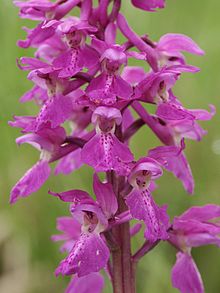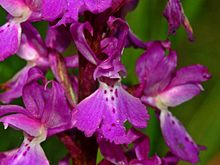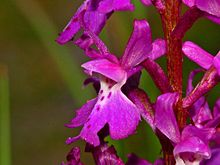- Orchis mascula
-
Early Purple Orchid 
Flowers of Orchis mascula Scientific classification Kingdom: Plantae (unranked): Angiosperms (unranked): Monocots Order: Asparagales Family: Orchidaceae Subfamily: Orchidoideae Tribe: Orchideae Subtribe: Orchidinae Alliance: Orchis Genus: Orchis Species: O. mascula Binomial name Orchis mascula
L.Orchis mascula, the Early Purple Orchid, is a species of orchid in the genus Orchis.
Contents
Etymology
The specific name is derived from the Latin "masculus", meaning "male" or "virile" and it should refer to the robust aspect of this species or to the shape of the tubers, similar to a pair of testicles.
Description
Orchis mascula is a herbaceous plant with stems up to 50–60 centimetres (20–24 in) of height, green at the base and purple on the apex. The root system consists of two tubers, rounded or ellipsoid. The leaves, grouped at the base of the stem, are oblong-lanceolate, pale green, sometimes with brownish-purple speckles. The inflorescence is 7.5–12.5 centimetres (3.0–4.9 in) long and it is composed of 6 to 20 flowers gathered in dense cylindrical spikes. The flower size is about 2.5 centimetres (0.98 in) and the color varies from pink to violet. The lateral sepals are ovate-lanceolate and erect, the median one, together with the petals, is smaller and cover the gynostegium. The labellum is three-lobed and convex, with crenulated margins and the basal part clearer and dotted with purple-brown spots. The spur is cylindrical or clavate, horizontal or ascending. The gynostegium is short, with reddish-green anthers. It blooms from April to June.
Reproduction
This orchid is devoid of nectar and attracts pollinating insects (wasps of the genera Apis, Bombus, Eucera, Andrena, Psithyrus, Xylocopa and sometimes beetles) with the appearance of its flower which is reminiscent of other species.
Distribution
The species is widespread across Europe, from Portugal to the Caucasus (Ireland, Great Britain, Norway, Sweden, Finland, Spain, France, Belgium, Netherlands, Germany, Denmark, Austria, Hungary, Switzerland, Italy, former Yugoslavia, Albania, Greece, Turkey, Bulgaria, Romania, Poland, Ukraine, most of Russia), in northwest Africa (Algeria, Tunisia, Morocco) and in the Middle East (Lebanon, Syria, Iraq) up to Iran.
Habitat
It grows in a variety of habitats, from meadows to mountain pastures and woods, in full sun or shady areas, from 0–2,500 metres (0–8,200 ft) above sea level.
Culture
It is referred to as "long purple" by Gertrude in Shakespeare's Hamlet. Gertrude: "Of crow-flowers, nettles, daisies, and long purples, that liberal shepards give a grosser name".
A flour called salep or sachlav is made of the ground tubers of this or some other species of orchids. It contains a nutritious starch-like polysaccharide called glucomannan. In some magical traditions, its root is called Adam and Eve Root. It is said that witches used tubers of this orchid in love potions.
Traditional use
Extracts of Orchis mascula can be found in various ayurvedic medicines such as confido and speman.[citation needed]
Gallery
Subspecies
- Orchis mascula subsp. hispanica (A.Niesch. & C.Niesch.) Soó (1972) (Southern Pyrenees, Spain, Portugal, Morocco)
- Orchis mascula subsp. longibracteatoides Balayer (1986) (Eastern Pyrenees)
- Orchis mascula subsp. longicalcarata Akhalkatski, H. Baumann, R. Lorenz, Mosulishvili &R. Peter (2005) (Eastern and central Caucasus)
- Orchis mascula subsp. maghrebiana B. Baumann & H. Baumann (2005)(Morocco)
- Orchis mascula subsp. mascula (N. & C. Europe to Iran, Canary Islands)
- Orchis mascula subsp. pinetorum (Boiss. & Kotschy) E.G.Camus (1908) (Macedonia to Iran)
- Orchis mascula subsp. speciosa (Mutel) Hegi (1909) (Europe)
- Orchis mascula subsp. wanjkovii (E.Wulff) Soó in G.Keller & al. (1932) (Crimea)
Synonyms
- Orchidactyla kromayeri (M.Schulze) Borsos & Soó 1966;
- Orchidactyla pentecostalis (Wettst. & Sennholz) Borsos & Soó 1966 ;
- Orchidactyla speciosissima (Wettst. & Sennholz) Borsos & Soó 1966;
- Orchis brevicornis var. fallax De Not. 1844;
- Orchis cochleata Fleischm. & M.Schulze 1902;
- Orchis compressiflora Stokes 1812 ;
- Orchis fallax (De Not.) Willk. in Willk. & J.M.C.Lange 1861
- Orchis glaucophylla A.Kern. 1864
- Orchis kromayeri M.Schulze 1904
- Orchis mascula f. longifolia Landwehr 1977
- Orchis mascula subsp. occidentalis O.Schwarz 1949
- Orchis mascula subsp. signifera (Vest) Soó 1927
- Orchis mascula subsp. tenera (Landwehr) Del Prete 1999
- Orchis mascula var. acutiflora W.D.J.Koch 1837
- Orchis mascula var. bicolor Balayer 1986
- Orchis mascula var. fallax E.G.Camus 1889
- Orchis mascula var. hostii Patze, E.Mey. & Elkan 1848
- Orchis mascula var. maritzii J.A.Guim. 1887
- Orchis mascula var. monsignatica Font Quer 1928
- Orchis mascula var. obtusiflora W.D.J.Koch 1837
- Orchis mascula var. speciosa Mutel 1836
- Orchis mascula var. tenera Landwehr 1977
- Orchis monsignatica (Font Quer) Rivas Goday 1941
- Orchis morio f. mascula L. 1753
- Orchis morio var. mascula L. 1753 (basionym)
- Orchis obtusa Schur 1866
- Orchis obtusiflora Schur 1853
- Orchis olivetorum Gren. ex Nyman 1882
- Orchis ovalis F.W.Schmidt 1791
- Orchis parreissii C.Presl 1845
- Orchis patens var. fallax (De Not.) Rchb.f. 1851
- Orchis pentecostalis Wettst. & Sennholz 1889
- Orchis signifera Vest 1824
- Orchis speciosa Host 1831;
- Orchis speciosissima Wettst. & Sennholz 1889;
- Orchis stabiana Tenore 1833;
- Orchis tenera (Landwehr) Kreutz 1991;
- Orchis untchji M.Schulze 1907;
- Orchis vernalis Salisbury 1796;
- Orchis wanjkovii E.Wulff 1930;
- Orchis wilmsii K.Richt. 1890[1]
References
- ^ Synonyms in Orchidspecies
- Pierre Delforge - Orchids of Europe, North Africa And the Middle East - 2006, Timber Press
- Pignatti S. - Flora d'Italia (3 voll.) - Edagricole – 1982, Vol. III
- Tutin, T.G. et al. - Flora Europaea, second edition - 1993
External links
Categories:- Orchid species
- Orchis
- Orchidoideae stubs
Wikimedia Foundation. 2010.












